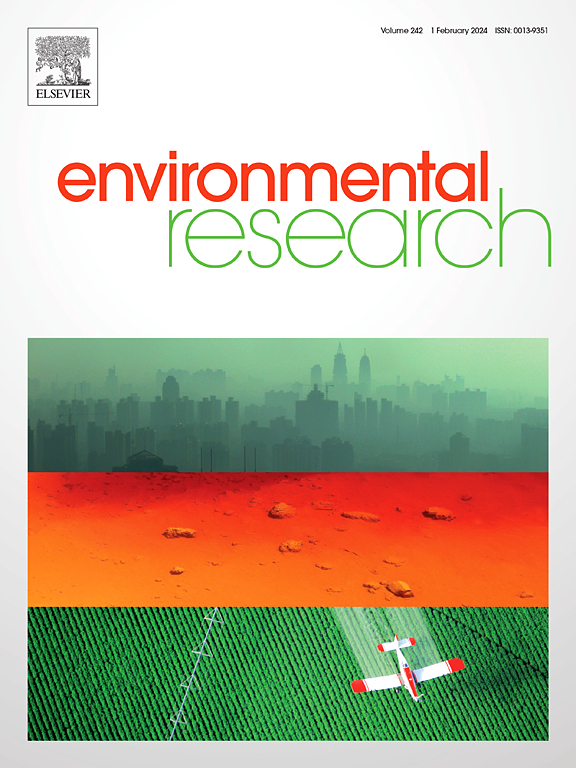美国淡水鱼中的汞、多氯联苯、全氟辛烷磺酸/全氟辛烷磺酸和杀虫剂化学混合物及其对鱼类消费构成的风险。
IF 7.7
2区 环境科学与生态学
Q1 ENVIRONMENTAL SCIENCES
引用次数: 0
摘要
背景:淡水鱼是重要的食物来源,但由于环境化学物质在其组织中的生物累积作用,淡水鱼也会对人类和野生动物的健康造成危害。尽管大多数研究、鱼类消费建议和法规都侧重于单个污染物,但鱼类消费者会接触到化学品混合物,包括遗留污染物和新出现的污染物,它们可能会产生综合影响。新出现的受关注化学品是危害的一个来源,但遗留污染物由于其在环境中的持久性,仍会对鱼类消费者构成威胁:我们研究了以下问题1) 不同化学物质在鱼类组织中是否相互关联?2) 不同化学物质在鱼类组织中的含量如何随时间和地点而变化?本研究利用美国环保署建立和维护的多个国家数据源(NRSA、NCCA-GL、GLENDA 和 NLFTS),研究了美国湖泊、池塘、溪流和河流中淡水鱼体内化学物质的共存情况:结果:我们发现有机污染物相互关联,但一般与汞无关;随着时间的推移,有机化学物质有所减少,但汞并未减少;鱼类体内遗留污染物的浓度--即使是那些已被禁用数十年的污染物--仍然超过了基于风险的筛选水平:讨论:尽管在减少污染物排放方面取得了一些成功,但鱼类组织中的一些污染物并没有减少,遗留和新出现的污染物继续对美国的鱼类消费者构成风险。鱼类组织中化学物质之间的相关性表明,美国人普遍暴露于混合物,但有机污染物通常与汞并不相关,这一点尤其值得注意,因为美国的鱼类消费建议通常是根据汞的含量制定的,并没有考虑多种污染物的暴露情况。虽然国家水产资源调查(NARS)计划等项目旨在系统监测鱼类组织中的污染物及其他环境指标,但要维持这种监测,需要美国联邦政府的持续支持。此外,还需要在州和联邦层面加大立法和监管力度,以减少持续来源和持续污染。本文章由计算机程序翻译,如有差异,请以英文原文为准。

Chemical mixtures of mercury, PCBs, PFAS, and pesticides in freshwater fish in the US and the risks they pose for fish consumption
Background
Freshwater fish are important food sources that also pose risks to human and wildlife health because of the bioaccumulation of environmental chemicals in their tissues. Although most studies, fish consumption advisories, and regulations focus on individual contaminants, fish consumers are exposed to mixtures of chemicals, including legacy contaminants and contaminants of emerging concern, that can have combined effects. Chemicals of emerging concern represent one source of hazard, but legacy contaminants can still pose threats to fish consumers due to their persistence in the environment.
Objectives
We investigate the following questions: 1) Do different chemicals correlate with one another in fish tissue, and if so, how? 2) How do levels of different chemicals in fish tissue vary by time and location? and 3) How do observed chemical levels compare with risk-based screening levels?
Methods
Using several national data sources established and maintained by the US Environmental Protection Agency (NRSA, NCCA-GL, GLENDA, and NLFTS), this study examines the co-occurrence of chemicals in freshwater fish in lakes, ponds, streams, and rivers in the US.
Results
We determine that organic contaminants correlate with one another, but generally not with mercury; organic chemicals have declined over time, but mercury has not; and fish concentrations of legacy contaminants—even those banned for decades—continue to exceed risk-based screening levels.
Discussion
Despite some successes in curtailing release of pollutants, some contaminants in fish tissue have not declined and legacy and emerging pollutants continue to pose risks to fish consumers in the US. Correlations between chemicals in fish tissue suggest that exposures to mixtures is prevalent in the US but that organic contaminants do not generally correlate with mercury—noteworthy particularly since fish consumption advisories in the US are frequently driven by the level of mercury, and do not account for exposure to multiple contaminants. While programs such as the National Aquatic Resource Surveys (NARS) Program seek to systematically monitor contaminants in fish tissue and other environmental indicators, continuous support from the US federal government is required to sustain this monitoring. Moreover, greater legislative and regulatory efforts are required at both the state and federal levels to reduce continuing sources and ongoing contamination.
求助全文
通过发布文献求助,成功后即可免费获取论文全文。
去求助
来源期刊

Environmental Research
环境科学-公共卫生、环境卫生与职业卫生
CiteScore
12.60
自引率
8.40%
发文量
2480
审稿时长
4.7 months
期刊介绍:
The Environmental Research journal presents a broad range of interdisciplinary research, focused on addressing worldwide environmental concerns and featuring innovative findings. Our publication strives to explore relevant anthropogenic issues across various environmental sectors, showcasing practical applications in real-life settings.
 求助内容:
求助内容: 应助结果提醒方式:
应助结果提醒方式:


